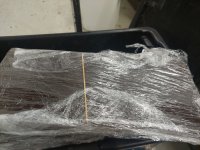

just making oxalic gly strips at the mo. borrowed some gear, got some gear in from beequip and as per normal modified it a bit.
as you can see i made a rough stirrer holder. mounted a cheap paint stirrer. please note a mortar stirrer would be better, or at least a low speed paint stirrer. this one i run on low and its not great. i doubt it will last long.
so what the stirrer does is to keep the OA moving and not get to hot on the bottom of the tank. you need about 55c to dissolve everything, but you need to keep under 60c. thats a really really tight window to stay in. go to high (i'm told) that it breaks down into formic acid, which is soluble in glycerin. formic is really hard on bees especially queens. that might explain some of the hive deaths.
it also breaks up the oxalic acid clumps.
the other big factor is humidity. glycerin soaks up moisture when exposed to air. something we want to avoid when the strips are out of the hive as it will start "growing acid crystals" on the surface. that doesn't hurt the bees (as some people claim) but rather its a waste of acid and the strips hold very little acid.. wet oxalic acid kills varroa 3x better than the dry acid on the surface.
making in a damp garage is not a good idea. auckland/northland humidity is really bad for this. need to keep the room super dry.
this also means we want to keep the manufacturing time to a minimum. leaving it to heat up overnight while exposed to air is not good.
do not leave the gly lids off. once the gly soaks up moisture its not useable.
the next thing is we want to keep the strips warm while they soak. so need a room you can keep hot.
so thats why i've set it up in the hot room with the dehumidifier. its only 35c 25% rh.
one downside i found with the kit is the method of keeping the strips in solution. they expand so much it pushes the lid up. the guys we borrowed the gear from started using metal weights instead of the standard method using blocks of wood and weight on top of the lid. something i will look at next time. i would really like to keep the lids clipped on.
also i hear people mentioning different colored strips. they should all be the same. beequip has a poor pic of a tub with different colored strips. it can look like that due to the lights refection, but if you look at a different angle they all look the same IF they stay covered in acid mix.
basic procedure.
put all the gear in the hot room, turn the room heater on and the dehumidifier. test the tank heater and check the thermostat. this one gets it to 55c when set to 60c. thats good so we won't overshoot the temp. remember these are cheap tanks and thermostats drift with age.
leave the gear overnight. that way the gly, acid, strips and water jacket warm up to hot room temp and it speeds up processing time.
turn on heater. set to 60c. i don't see the point of setting it higher and risking overshooting temps. i don't see the need to wait until the water jacket has heated up but it won't hurt.
pour in the gly that you have measured out. it should be runny due to the heat of the room.
turn stirrer on, nice slow speed.
pour in the acid in smallish amounts. break up all the big lumps before you open the bag. i find the stirrer breaks up the chunks but careful to not put to much in at once.
once the required amount of acid is in, its coffee break time. let it heat up and the stirrer will break everything up. come back when the heater light has gone out and check temps.
pour out some mix into a sizeable bucket at full speed. open valve fully, as some acid gets stuck in the valve. probably pour out 5-10 liters or so. tip it back in to mix. let it dissolve in.
coffee time
it should hit 55c and the mix go clear.
set up the containers as per kit instructions.
fill almost to the brim. do not clip the lids on.
check later on once the cardboard has expanded to make sure its still covered. it must remain covered by acid mix at all times. top it off if need be.
btw this is where stainless weights on the strips would be better, make it a lot easier.
leave it overnight.
move strips to draining rack (not drying!). they should all look the same color.
once the excess has drained, off wrap the bundles of strips. do not dry the strips. ideally vacuum pack them. otherwise wrapping in shrink wrap works ok for short term storage. with room at 35c its still very liquid and easy to drain. it should set jelly like at colder temps.

of course safety gear etc, you will spill acid so be able to clean it. mask for the oxalic dust.



